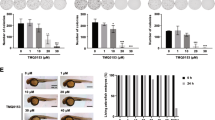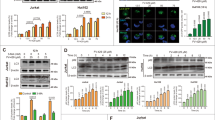Abstract
Ceramide metabolism has emerged as a potential target for anticancer therapy. Here, the potential usefulness of two novel synthetic ceramide analogs as anti-leukemic drugs was investigated. Compounds AD2646 and AD2687 were able to dose-and time-dependently decrease the viability of Jurkat leukemic cells. This was accompanied by an accumulation of endogenous ceramide owing to perturbed ceramide metabolism. Cytotoxicity involved caspase activation but also necrotic-like features, as evidenced by phosphatidylserine externalization, membrane permeability, hypodiploidy, caspase processing and only partial protection from cell death by a pan-caspase inhibitor. Ceramide analogs also induced cell death in Jurkat mutants that are deficient in cell death signaling proteins, including FADD, caspase-8 and 10, and RIP. While overexpression of Bcl-xL did not suppress ceramide accumulation, it conferred robust protection from caspase activation and cell death. Altogether, these novel ceramide analogs are able to kill leukemic cells through distinct pathways implicating caspase activation and mitochondrial events, and represent a new group of bioactive molecules with potential applications in anticancer therapy.
This is a preview of subscription content, access via your institution
Access options
Subscribe to this journal
Receive 12 print issues and online access
$259.00 per year
only $21.58 per issue
Buy this article
- Purchase on Springer Link
- Instant access to full article PDF
Prices may be subject to local taxes which are calculated during checkout





Similar content being viewed by others
Abbreviations
- DEVD-AMC:
-
Ac-Asp-Glu-Val-Asp-aminomethylcoumarin
- FCS:
-
fetal calf serum
- GlcCer:
-
glucosylceramide
- MTT:
-
3-(4,5-dimethylthiazol-2-yl)-2,5-diphenyltetrazolium bromide
- SM:
-
sphingomyelin
- TLC:
-
thin layer chromatography
- z-VAD-fmk:
-
benzyloxycarbonyl-Val-Ala-Asp-fluoromethylketone
References
Ogretmen B, Hannun YA . Biologically active sphingolipids in cancer pathogenesis and treatment. Nat Rev Cancer 2004; 4: 604–616.
Obeid LM, Linardic CM, Karolak LA, Hannun YA . Programmed cell death induced by ceramide. Science 1993; 259: 1769–1771.
Senchenkov A, Litvak DA, Cabot MC . Targeting ceramide metabolism – a strategy for overcoming drug resistance. J Natl Cancer Inst 2001; 93: 347–357.
Kok JW, Sietsma H . Sphingolipid metabolism enzymes as targets for anticancer therapy. Curr Drug Targets 2004; 5: 375–382.
Radin NS . Killing cancer cells by poly-drug elevation of ceramide levels: a hypothesis whose time has come? Eur J Biochem 2001; 268: 193–204.
Karasavvas N, Erukulla RK, Bittman R, Lockshin R, Zakeri Z . Stereospecific induction of apoptosis in U937 cells by N-octanoyl-sphingosine stereoisomers and N-octyl-sphingosine. The ceramide amide group is not required for apoptosis. Eur J Biochem 1996; 236: 729–737.
Kuroki J, Hirokawa M, Kitabayashi A, Lee M, Horiuchi T, Kawabata Y et al. Cell-permeable ceramide inhibits the growth of B lymphoma Raji cells lacking TNF-alpha-receptors by inducing G0/G1 arrest but not apoptosis: a new model for dissecting cell-cycle arrest and apoptosis. Leukemia 1996; 10: 1950–1958.
Bieberich E, Kawaguchi T, Yu RK . N-acylated serinol is a novel ceramide mimic inducing apoptosis in neuroblastoma cells. J Biol Chem 2000; 275: 177–181.
Selzner M, Bielawska A, Morse MA, Rudiger HA, Sindram D, Hannun YA et al. Induction of apoptotic cell death and prevention of tumor growth by ceramide analogues in metastatic human colon cancer. Cancer Res 2001; 61: 1233–1240.
Senchenkov A, Han TY, Wang H, Frankel AE, Kottke TJ, Kaufmann SH et al. Enhanced ceramide generation and induction of apoptosis in human leukemia cells exposed to DT(388)-granulocyte-macrophage colony-stimulating factor (GM-CSF), a truncated diphtheria toxin fused to human GM-CSF. Blood 2001; 98: 1927–1934.
Lopez-Marure R, Gutierrez G, Mendoza C, Ventura JL, Sanchez L, Reyes Maldonado E et al. Ceramide promotes the death of human cervical tumor cells in the absence of biochemical and morphological markers of apoptosis. Biochem Biophys Res Commun 2002; 293: 1028–1036.
Bieberich E, Silva J, Wang G, Krishnamurthy K, Condie BG . Selective apoptosis of pluripotent mouse and human stem cells by novel ceramide analogues prevents teratoma formation and enriches for neural precursors in ES cell-derived neural transplants. J Cell Biol 2004; 167: 723–734.
Samsel L, Zaidel G, Drumgoole HM, Jelovac D, Drachenberg C, Rhee JG et al. The ceramide analog, B13, induces apoptosis in prostate cancer cell lines and inhibits tumor growth in prostate cancer xenografts. Prostate 2004; 58: 382–393.
Struckhoff AP, Bittman R, Burow ME, Clejan S, Elliott S, Hammond T et al. Novel ceramide analogs as potential chemotherapeutic agents in breast cancer. J Pharmacol Exp Ther 2004; 309: 523–532.
Novgorodov SA, Szulc ZM, Luberto C, Jones JA, Bielawski J, Bielawska A et al. Positively charged ceramide is a potent inducer of mitochondrial permeabilization. J Biol Chem 2005; 280: 16096–16105.
Dagan A, Wang C, Fibach E, Gatt S . Synthetic, non-natural sphingolipid analogs inhibit the biosynthesis of cellular sphingolipids, elevate ceramide and induce apoptotic cell death. Biochim Biophys Acta 2003; 1633: 161–169.
Boise LH, Thompson CB . Bcl-x(L) can inhibit apoptosis in cells that have undergone Fas-induced protease activation. Proc Natl Acad Sci USA 1997; 94: 3759–3764.
Milhas D, Cuvillier O, Therville N, Clave P, Thomsen M, Levade T et al. Caspase-10 triggers Bid cleavage and caspase cascade activation in FasL-induced apoptosis. J Biol Chem 2005; 280: 19836–19842.
Segui B, Cuvillier O, Adam-Klages S, Garcia V, Malagarie-Cazenave S, Leveque S et al. Involvement of FAN in TNF-induced apoptosis. J Clin Invest 2001; 108: 143–151.
Bielawska A, Perry DK, Hannun YA . Determination of ceramides and diglycerides by the diglyceride kinase assay. Anal Biochem 2001; 298: 141–150.
He X, Dagan A, Gatt S, Schuchman EH . Simultaneous quantitative analysis of ceramide and sphingosine in mouse blood by naphthalene-2,3-dicarboxyaldehyde derivatization after hydrolysis with ceramidase. Anal Biochem 2005; 340: 113–122.
Kolesnick R . The therapeutic potential of modulating the ceramide/sphingomyelin pathway. J Clin Invest 2002; 110: 3–8.
Jarvis WD, Kolesnick RN, Fornari FA, Traylor RS, Gewirtz DA, Grant S . Induction of apoptotic DNA damage and cell death by activation of the sphingomyelin pathway. Proc Natl Acad Sci USA 1994; 91: 73–77.
Geley S, Hartmann BL, Kofler R . Ceramides induce a form of apoptosis in human acute lymphoblastic leukemia cells that is inhibited by Bcl-2, but not by CrmA. FEBS Lett 1997; 400: 15–18.
Wieder T, Geilen CC, Kolter T, Sadeghlar F, Sandhoff K, Brossmer R et al. Bcl-2 antagonizes apoptotic cell death induced by two new ceramide analogues. FEBS Lett 1997; 411: 260–264.
Bieberich E, Hu B, Silva J, MacKinnon S, Yu RK, Fillmore H et al. Synthesis and characterization of novel ceramide analogs for induction of apoptosis in human cancer cells. Cancer Lett 2002; 181: 55–64.
Macchia M, Bertini S, Fogli S, Giovannetti E, Minutolo F, Rapposelli S et al. Ceramide analogues in apoptosis: a new strategy for anticancer drug development. Farmaco 2003; 58: 205–211.
Crawford KW, Bittman R, Chun J, Byun HS, Bowen WD . Novel ceramide analogues display selective cytotoxicity in drug-resistant breast tumor cell lines compared to normal breast epithelial cells. Cell Mol Biol (Noisy-le-grand) 2003; 49: 1017–1023.
Shabbits JA, Mayer LD . High ceramide content liposomes with in vivo antitumor activity. Anticancer Res 2003; 23: 3663–3669.
Park YS, Hakomori S, Kawa S, Ruan F, Igarashi Y . Liposomal N,N,N-trimethylsphingosine (TMS) as an inhibitor of B16 melanoma cell growth and metastasis with reduced toxicity and enhanced drug efficacy compared to free TMS: cell membrane signaling as a target in cancer therapy. Cancer Res 1994; 54: 2213–2217.
Belaud-Rotureau MA, Lacombe F, Durrieu F, Vial JP, Lacoste L, Bernard P et al. Ceramide-induced apoptosis occurs independently of caspases and is decreased by leupeptin. Cell Death Differ 1999; 6: 788–795.
Engedal N, Saatcioglu F . Ceramide-induced cell death in the prostate cancer cell line LNCaP has both necrotic and apoptotic features. Prostate 2001; 46: 289–297.
Mochizuki T, Asai A, Saito N, Tanaka S, Katagiri H, Asano T et al. Akt protein kinase inhibits non-apoptotic programmed cell death induced by ceramide. J Biol Chem 2002; 277: 2790–2797.
Zhao S, Yang YN, Song JG . Ceramide induces caspase-dependent and -independent apoptosis in A-431 cells. J Cell Physiol 2004; 199: 47–56.
Jaffrezou JP, Maestre N, de Mas-Mansat V, Bezombes C, Levade T, Laurent G . Positive feedback control of neutral sphingomyelinase activity by ceramide. FASEB J 1998; 12: 999–1006.
Ogretmen B, Pettus BJ, Rossi MJ, Wood R, Usta J, Szulc Z et al. Biochemical mechanisms of the generation of endogenous long chain ceramide in response to exogenous short chain ceramide in the A549 human lung adenocarcinoma cell line. J Biol Chem 2002; 277: 12960–12969.
Maurer BJ, Melton L, Billups C, Cabot MC, Reynolds CP . Synergistic cytotoxicity in solid tumor cell lines between N-(4-hydroxyphenyl)retinamide and modulators of ceramide metabolism. J Natl Cancer Inst 2000; 92: 1897–1909.
Meng A, Luberto C, Meier P, Bai A, Yang X, Hannun YA et al. Sphingomyelin synthase as a potential target for D609-induced apoptosis in U937 human monocytic leukemia cells. Exp Cell Res 2004; 292: 385–392.
Batra S, Reynolds CP, Maurer BJ . Fenretinide cytotoxicity for Ewing's sarcoma and primitive neuroectodermal tumor cell lines is decreased by hypoxia and synergistically enhanced by ceramide modulators. Cancer Res 2004; 64: 5415–5424.
Acknowledgements
We thank Dr O Cuvillier (INSERM U.466, Toulouse) for providing Jurkat/neo and Jurkat/Bcl-xL clones. The technical assistance of N Therville is acknowledged. This study was supported by grant 607/02 from the Israel Science Foundation (to AD and SG), INSERM (to DM, SC, BS and TL) and ARC 3417 (to BS).
Author information
Authors and Affiliations
Corresponding author
Additional information
Supplementary Information accompanies the paper on the Leukemia website (http://www.nature.com/leu).
Rights and permissions
About this article
Cite this article
Granot, T., Milhas, D., Carpentier, S. et al. Caspase-dependent and -independent cell death of Jurkat human leukemia cells induced by novel synthetic ceramide analogs. Leukemia 20, 392–399 (2006). https://doi.org/10.1038/sj.leu.2404084
Received:
Revised:
Accepted:
Published:
Issue Date:
DOI: https://doi.org/10.1038/sj.leu.2404084
Keywords
This article is cited by
-
Role of Acid Ceramidase in Resistance to FasL: Therapeutic Approaches Based on Acid Ceramidase Inhibitors and FasL Gene Therapy
Molecular Therapy (2007)
-
Lysosomotropic acid ceramidase inhibitor induces apoptosis in prostate cancer cells
Cancer Chemotherapy and Pharmacology (2007)



